Demolition Contractors Queenborough
Find the best Demolition Contractor in Queenborough
Get multiple Demolition Contractors quotes for your project today! Compare profiles, reviews, accreditations, portfolio, etc... and choose the best offer.
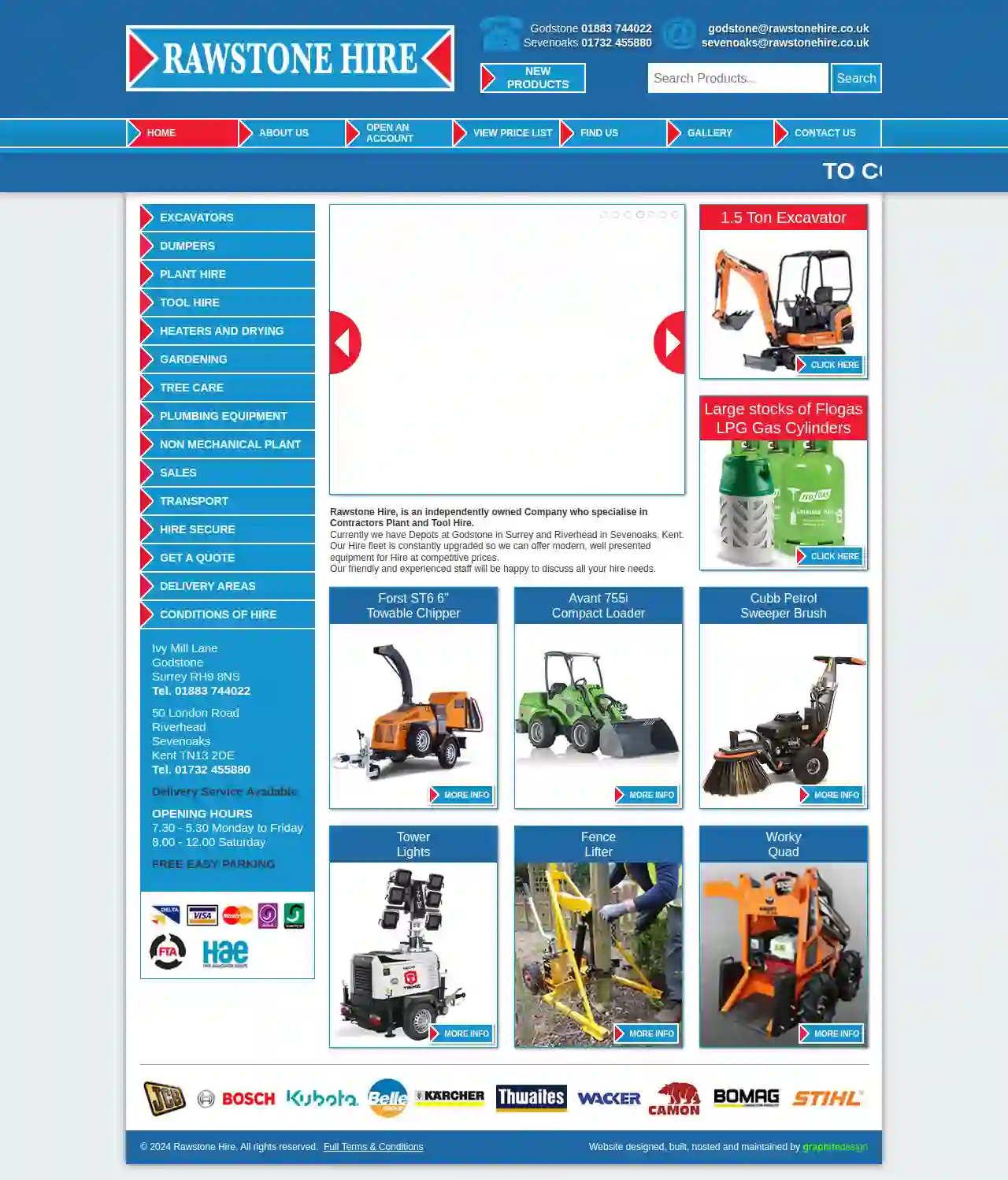
Rawstone Hire
433 reviewsIvy Mill Lane, GodstoneSurrey, Ivy Mill LaneGodstoneSurrey, Godstone, RH9 8NS, GBRawstone Hire: Your Trusted Partner for Plant and Tool Hire Rawstone Hire is an independently owned company specializing in providing contractors with top-quality plant and tool hire solutions. We have depots strategically located in Godstone, Surrey, and Riverhead, Sevenoaks, Kent, ensuring convenient access to our extensive hire fleet. Our commitment to excellence is reflected in our constantly upgraded equipment, offering modern, well-presented tools and machinery at competitive prices. At Rawstone Hire, we understand the importance of reliable and efficient equipment for your projects. Our friendly and experienced team is dedicated to providing personalized service and expert advice to meet your specific hire needs. Whether you require excavators, dumpers, or a wide range of tools, we have the right equipment to support your success. We take pride in offering a comprehensive range of services, including: Plant Hire Tool Hire Heaters and Drying Equipment Gardening Equipment Tree Care Equipment Plumbing Equipment Non-Mechanical Plant Sales Transport Hire Secure Our commitment to customer satisfaction is evident in our dedication to providing a seamless experience. We offer convenient delivery services and flexible hire options to suit your project requirements. Contact us today to discuss your hire needs and let us help you achieve your project goals.
- Services
- Why Us?
- Gallery
Get Quote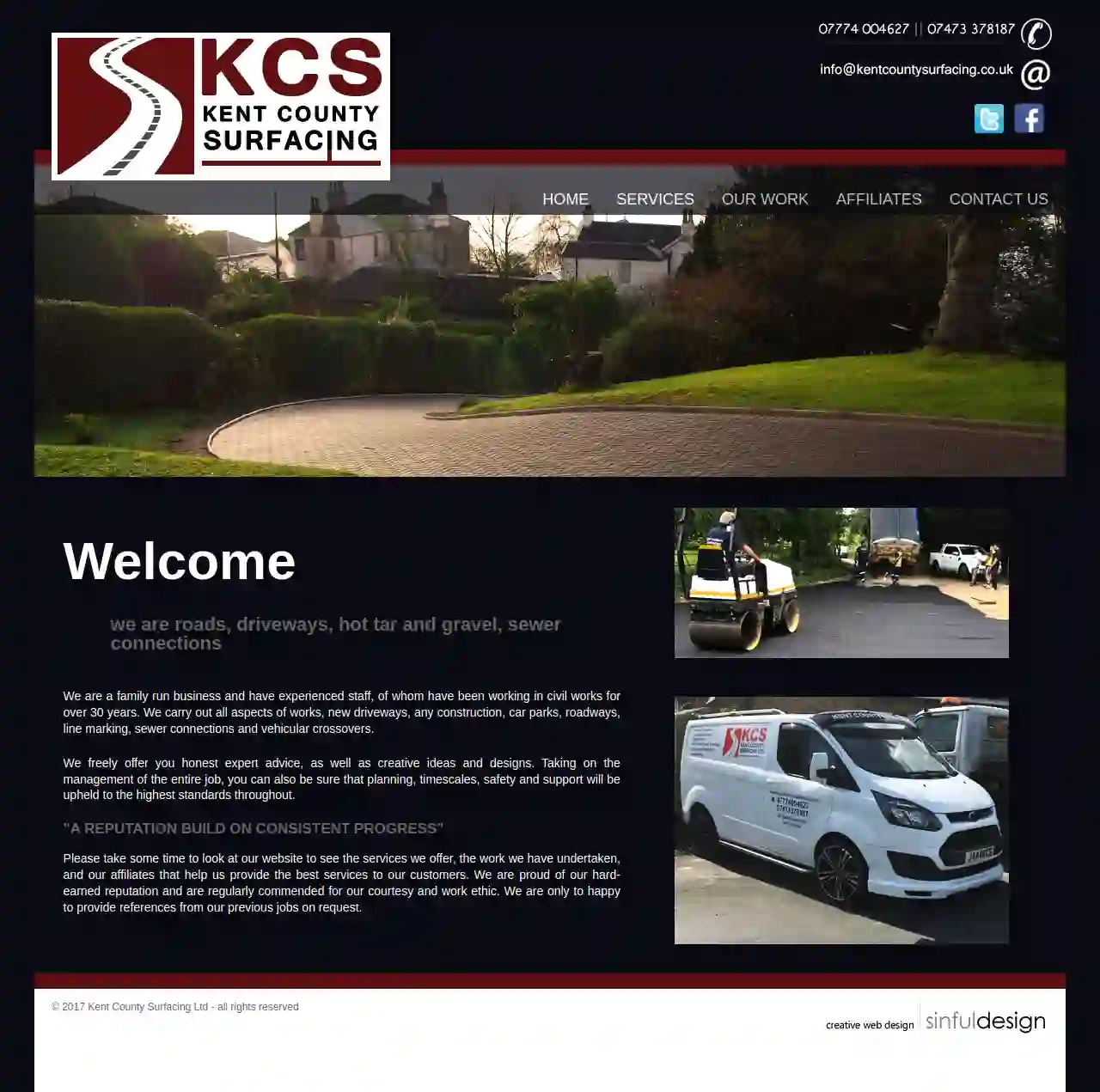
Oatmor Harris Excavations Ltd
Deal, GBKent County Surfacing: Your Trusted Partner for Roads, Driveways, and More Kent County Surfacing is a family-run business with a rich history spanning over 30 years. Our experienced team specializes in all aspects of civil works, from new driveways and construction projects to car parks, roadways, and sewer connections. We are committed to providing our clients with honest expert advice, creative designs, and meticulous project management. We take pride in upholding the highest standards of planning, safety, and support throughout every project. We are proud of our hard-earned reputation for consistent progress, courtesy, and work ethic. We are regularly commended for our dedication to customer satisfaction. We are happy to provide references from our previous projects upon request. Explore our website to learn more about our services, view examples of our work, and discover our trusted affiliates who help us deliver exceptional results.
- Services
- Why Us?
- Gallery
Get Quote
Pine Hill Excavation Inc.
Cape Neddick/York, Maine, York, GBAbout Pine Hill Excavation Pine Hill Excavation was established in 2004 by Dana Goldberg, a seasoned professional with over 40 years of experience in excavation, landscaping, and construction. Dana has been a resident of Southern Maine for most of his life and currently resides there with his wife and three children. Known for its reliability and expertise, Pine Hill Excavation has earned the trust of numerous major contractors and local residents throughout Southern Maine. We are your go-to choice for all your excavation and aggregate delivery needs. Our service area encompasses York, Ogunquit, Kittery, Wells, The Berwicks, Elliott, and Kennebunk.
- Services
- Why Us?
- Our Team
- Gallery
Get Quote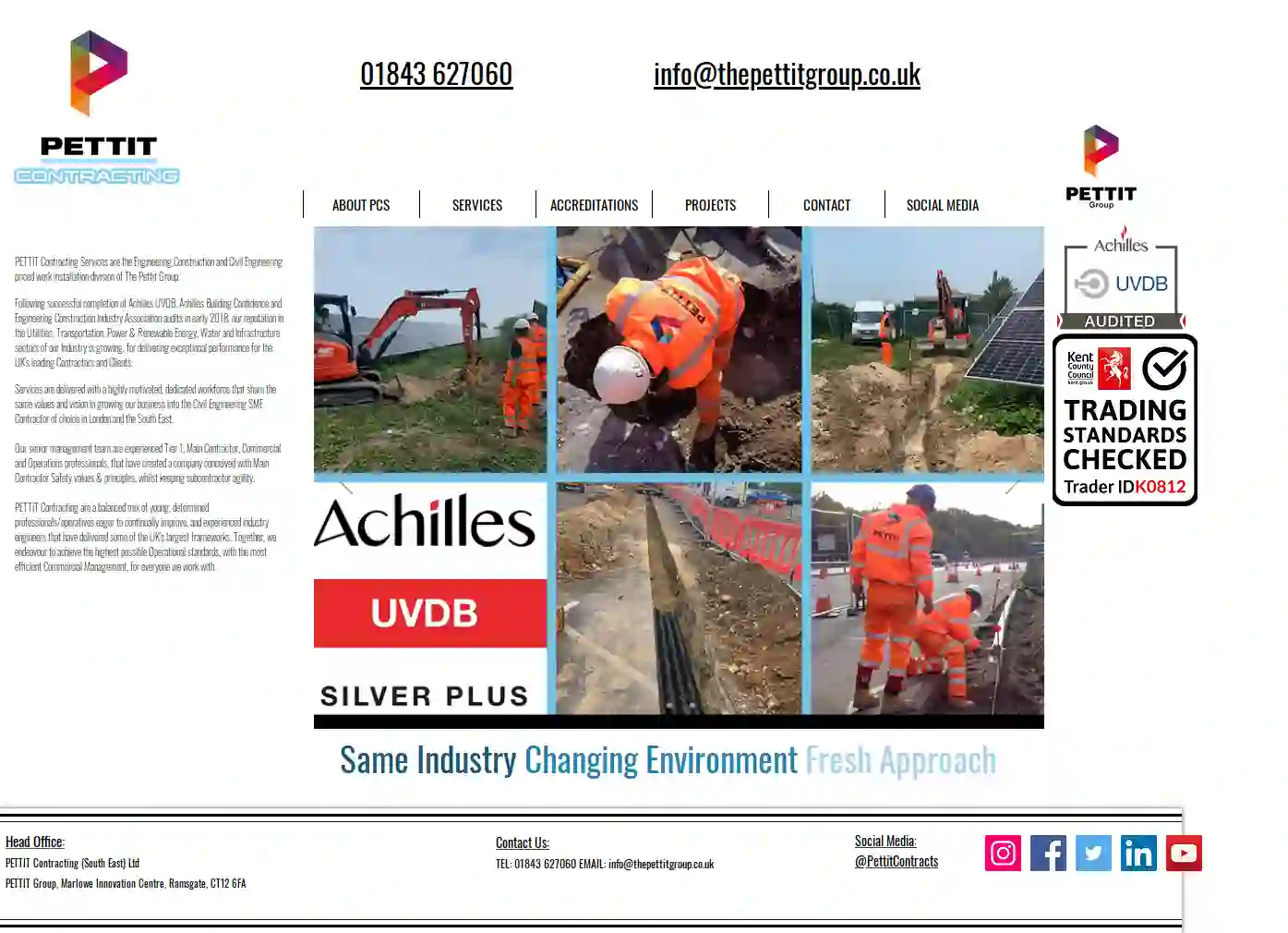
Pettit Contracting (south east) Ltd
52 reviewsPETTIT Group, Marlowe Innovation Centre, Ramsgate, CT12 6FA, GBPETTIT Contracting Services are the Engineering Construction and Civil Engineering priced work installation division of The Pettit Group. Following successful completion of Achilles UVDB, Achilles Building Confidence and Engineering Construction Industry Association audits in early 2018, our reputation in the Utilities, Transportation, Power & Renewable Energy, Water and Infrastructure sectors of our Industry is growing, for delivering exceptional performance for the UK's leading Contractors and Clients. Services are delivered with a highly motivated, dedicated workforce that share the same values and vision in growing our business into the Civil Engineering SME Contractor of choice in London and the South East. Our senior management team are experienced Tier 1, Main Contractor, Commercial and Operations professionals, that have created a company conceived with Main Contractor Safety values & principles, whilst keeping subcontractor agility. PETTIT Contracting are a balanced mix of young, determined professionals/operatives eager to continually improve, and experienced industry engineers that have delivered some of the UK's largest frameworks. Together, we endeavour to achieve the highest possible Operational standards, with the most efficient Commercial Management, for everyone we work with.
- Services
- Why Us?
- Gallery
Get Quote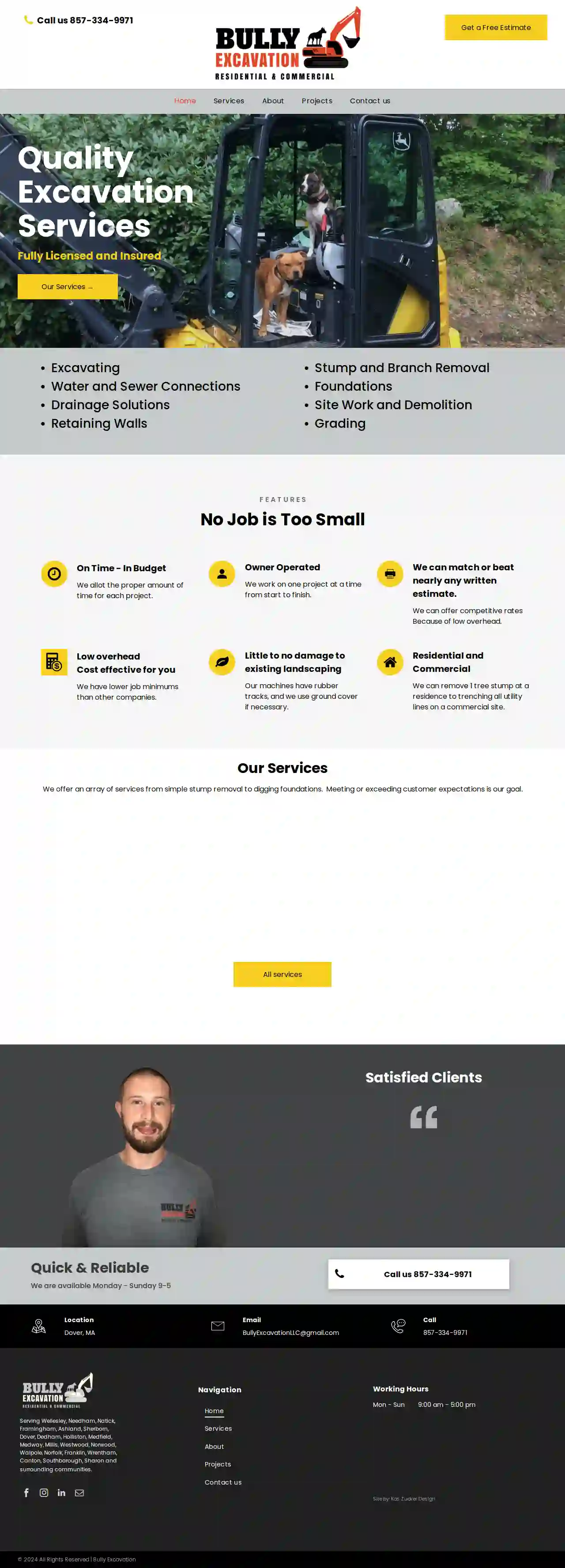
Bully excavation
Dover, MA, GBAbout Bully Excavation David Van Tassell, the founder and operator of Bully Excavation, has always had a passion for all things mechanical. Growing up, he spent countless hours working on cars and in his grandfather's wood shop. As a teenager, he often tackled his own car repairs. Dave graduated from Northeastern University in 2007 with a Bachelor's degree in Mechanical Engineering. After working as an engineer for Pratt and Whitney, he went on to work at a small start-up company in South Boston. Dave's entrepreneurial spirit and strong work ethic have made Bully Excavation a successful company. Our Mission At Bully Excavation, our mission is to provide our clients with high-quality excavation services, cost-effective construction, and clear communication. We strive to build lasting relationships with our customers by consistently exceeding their expectations. Need help with an outdoor project? Don't hesitate to reach out to us! We're here to help you get started.
- Services
- Why Us?
- Our Team
- Testimonials
- Gallery
Get Quote
LandWorks Excavation
57 reviewsDover, GBLooking for an experienced professional to tackle a project? Get guaranteed quality results with LandWorks Excavation. We offer tailored solutions and reliable services for a wide variety of needs, working with the dedication and craftsmanship that has earned us a reputation for excellence. Get in touch for a free quote today.
- Services
- Why Us?
- Testimonials
- Gallery
Get Quote
Thanet Drainage
4.821 reviewsThanet, GBThanet Drainage: Your Trusted Drain Experts in Kent Thanet Drainage is your go-to solution for all your drainage needs in Kent. We are a team of experienced and accredited professionals dedicated to providing reliable, rapid, and cost-effective drain unblocking and repair services. Whether you're dealing with a blocked drain, a burst water main, or need a comprehensive CCTV drain survey, we have the expertise and equipment to handle any challenge. Serving the Entire Thanet Area and Beyond We proudly serve the entire Thanet area, including Ramsgate, Margate, Broadstairs, Canterbury, Whitstable, Herne Bay, Sandwich, Deal, Dover, Birchington, and Folkestone. Our commitment to customer satisfaction is unwavering, and we strive to provide a seamless and stress-free experience for every client. Our Services We offer a wide range of drainage services, including: Drain Unblocking Drain Relining and Patch Lining High Pressure Water Jetting Excavation CCTV Drain Surveys Drain Descaling Burst Water Main Repairs Why Choose Thanet Drainage? We are a team of highly skilled and experienced drainage professionals who are committed to providing our clients with the highest quality service. We are also fully accredited and insured, giving you peace of mind that your project is in safe hands. Contact Us Today For a free quote or to discuss your drainage needs, please contact us today. We are available 24/7 to assist you with any emergency situations.
- Services
- Why Us?
- Accreditations
- Gallery
Get Quote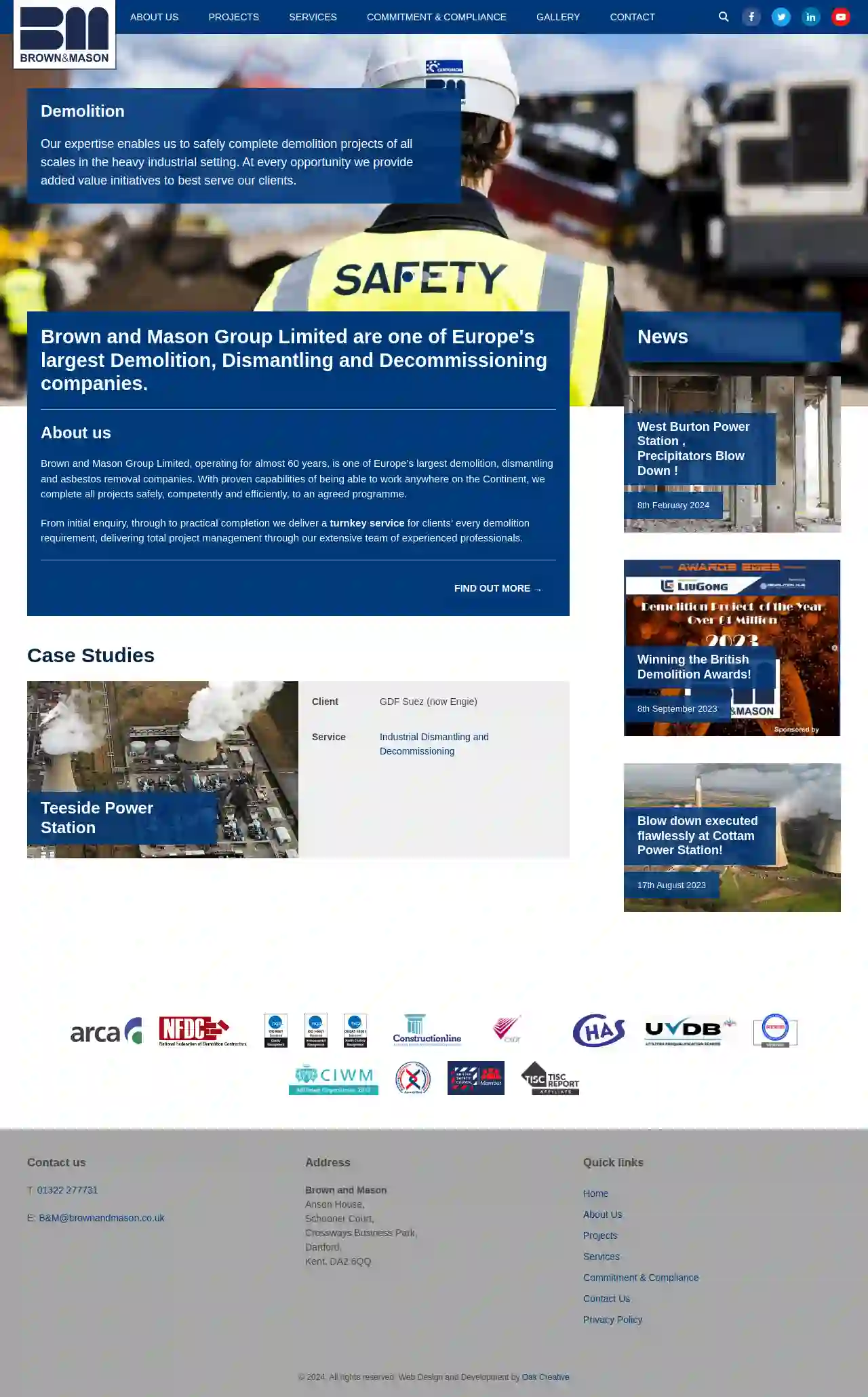
Brown & Mason
3.98 reviewsAnson House, Schooner Court, Crossways Business Park, Dartford, Kent., DA2 6QQ, GBAbout Brown and Mason Brown and Mason Group Limited was founded in 1961, when the Grandfather of several of the company’s current directors started out with just £400. Now, almost 60 years later, the Group has established itself as one of the largest industrial Decommissioning, Dismantling, Demolition and Asbestos removal companies in the world. With the proven ability to work anywhere on the globe, we complete all projects safely, competently and efficiently, to an agreed programme. Brown and Mason remains a family owned and run, private limited company. Our recent audited accounts show a turnover of £50 million, achieved by our directly employed workforce of over 300 individuals. From initial enquiry, through to practical completion, we deliver a turnkey service for clients’ every demolition requirement, delivering total project management through our extensive team of experienced professionals. During the course of the company’s history, the types of projects have been varied and have included: the removal of asbestos and total Decommissioning, Dismantling and Demolition of over 50 power stations; the demolition of the first multi-storey commercial building on the Paternoster Square development close to St Paul’s Cathedral in London; the asbestos removal and demolition of the former Department of Environment’s offices in Marsham Street, London (close to the Palace of Westminster). We have been involved with many other projects in varied markets including Nuclear power, Marine Decommissioning and we are one of the world’s leading specialists in the controlled explosive engineering sector. Brown and Mason Group Limited are long-standing members of the National Federation of Demolition Contractors (NFDC) and the Asbestos Removal Contractors Association (ARCA) and hold a full HSE asbestos removal license, for the removal of all types of asbestos. We hold many other accreditations which are all available to view on our accreditations page. Feel free to contact us to discuss your next project.
- Services
- Why Us?
- Accreditations
- Gallery
Get Quote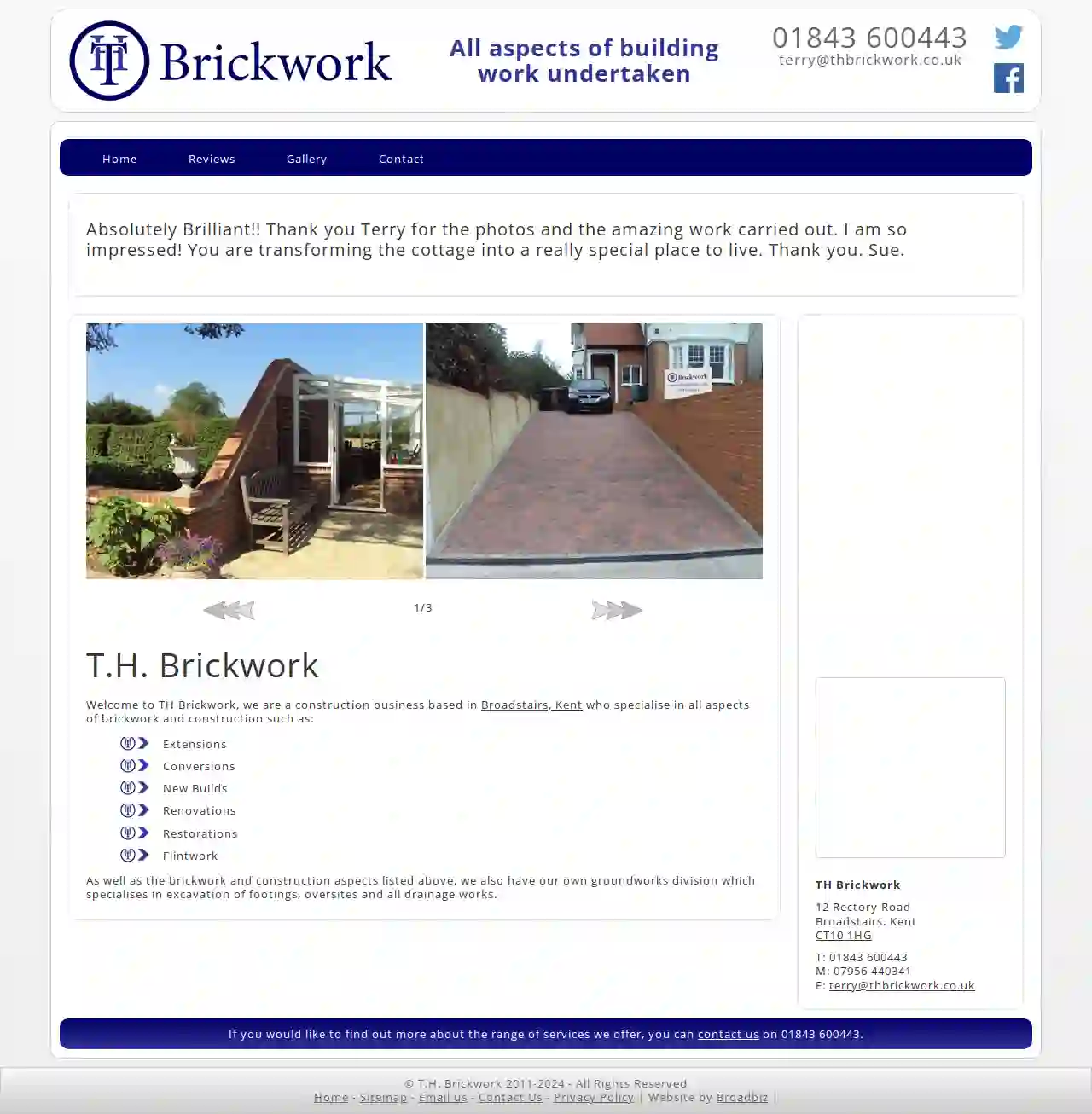
TH Brickwork
53 reviews12 Rectory Road, Broadstairs, CT10 1HG, GBWelcome to TH Brickwork We are a construction business based in Broadstairs, Kent who specialise in all aspects of brickwork and construction such as: Extensions Conversions New Builds Renovations Restorations Flintwork As well as the brickwork and construction aspects listed above, we also have our own groundworks division which specialises in excavation of footings, oversites and all drainage works.
- Services
- Why Us?
- Testimonials
- Gallery
Get Quote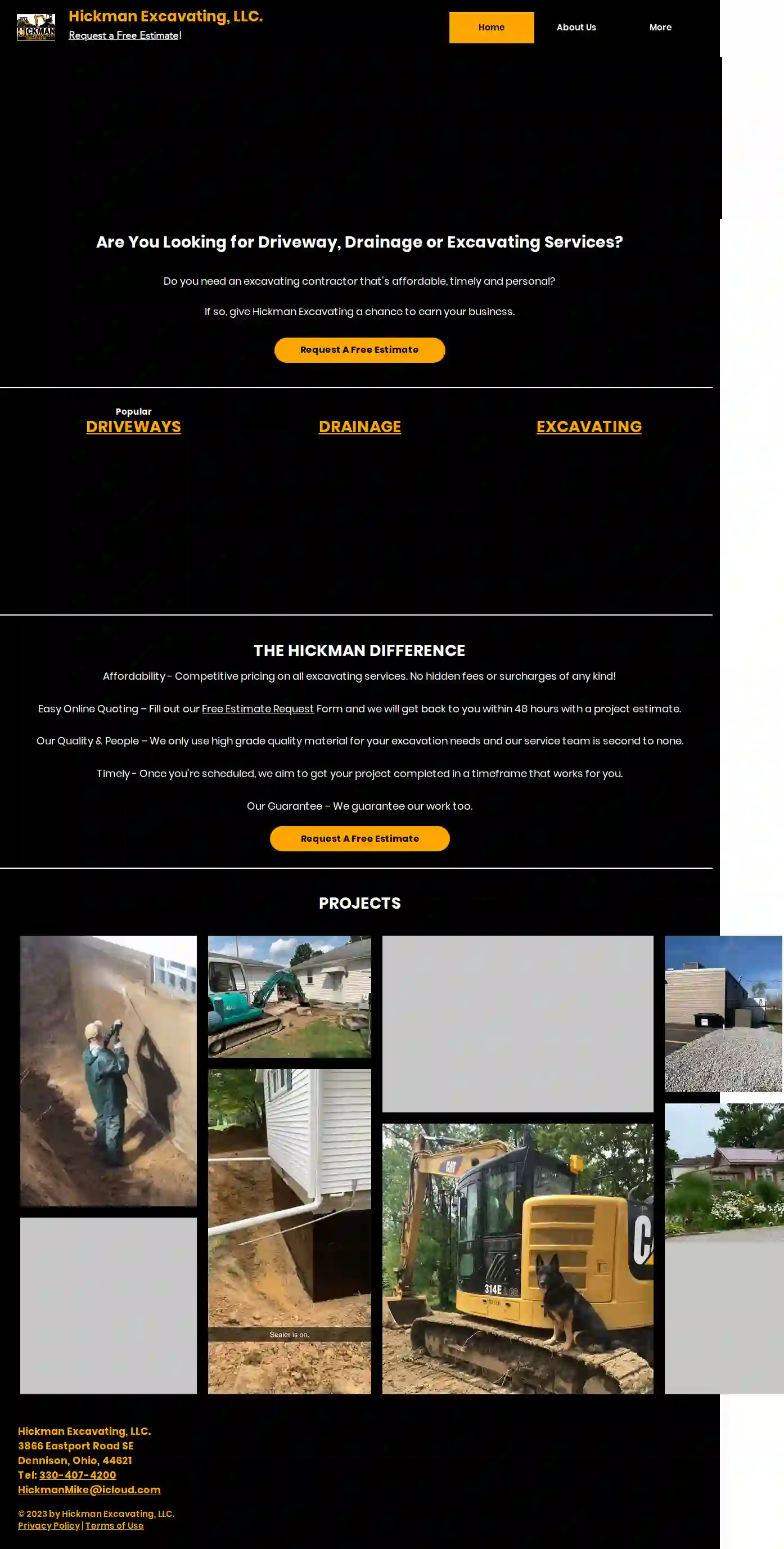
Hickman Excavating, LLC.
3866 Eastport Road SE, Dennison, 44621, GBAre You Looking for Driveway, Drainage or Excavating Services? Do you need an excavating contractor that's affordable, timely and personal? If so, give Hickman Excavating a chance to earn your business. THE HICKMAN DIFFERENCE Affordability - Competitive pricing on all excavating services. No hidden fees or surcharges of any kind! Easy Online Quoting – Fill out our Free Estimate Request Form and we will get back to you within 48 hours with a project estimate. Our Quality & People – We only use high grade quality material for your excavation needs and our service team is second to none. Timely - Once you're scheduled, we aim to get your project completed in a timeframe that works for you. Our Guarantee – We guarantee our work too.
- Services
- Why Us?
- Gallery
Get Quote
Over 13,059+ Excavation Contractors onboarded
Our excavation providers operate in Queenborough & surroundings!
ExcavationHQ has curated and vetted the Best Excavation Contractors in and around Queenborough. Find a reliable business today.
Frequently Asked Questions About Demolition Contractors
- 'Can I see proof of your licensing and insurance?' Verify their credentials and coverage.
- 'What experience do you have with projects like mine?' Ensure they have relevant expertise.
- 'Can you provide references from past clients?' Check their reputation and customer satisfaction.
- 'What are your safety protocols?' Prioritize contractors who emphasize safety.
- 'How will you handle hazardous materials?' Ensure they have proper procedures for asbestos or lead abatement.
- 'What is your timeline for completing the project?' Understand the project duration.
- 'How will you manage noise, dust, and debris?' Discuss mitigation measures for minimizing disruption.
- 'What are your payment terms?' Clarify payment schedules and any required deposits.
- Enclosure: Sealing off the asbestos-containing material to prevent fiber release.
- Encapsulation: Coating the asbestos-containing material with a sealant to bind the fibers.
- Removal: Carefully removing the asbestos-containing material and disposing of it safely.
- Experience: Look for companies with a proven track record and years of experience in the demolition industry.
- Licensing and Insurance: Ensure the contractor is properly licensed to operate in your area and carries adequate insurance to protect you from liability.
- Safety Record: Inquire about their safety protocols and accident history. A reputable contractor prioritizes safety.
- References and Reviews: Ask for references from past clients and check online reviews to gauge their reputation and customer satisfaction.
- Professionalism: Choose a company that communicates clearly, provides detailed estimates, and has a courteous and responsive team.
- Size and Complexity of the Structure: Larger and more complex structures, such as multi-story buildings, require more time, labor, and specialized equipment, increasing costs.
- Type of Demolition: Different demolition methods, such as implosion, wrecking ball, or high-reach demolition, have varying costs.
- Material Disposal: Disposal fees for demolition debris can contribute significantly to the overall cost, depending on the type and quantity of materials.
- Location and Accessibility: Demolition in densely populated areas or with limited access may require more planning and specialized equipment, affecting costs.
- Hazardous Materials: The presence of asbestos, lead paint, or other hazardous materials requires specialized removal and disposal procedures, adding to the expenses.
What questions should I ask a demolition contractor before hiring them?
What are the different methods of asbestos abatement?
How do I find a reputable demolition contractor?
How much does demolition cost in the UK?
What questions should I ask a demolition contractor before hiring them?
- 'Can I see proof of your licensing and insurance?' Verify their credentials and coverage.
- 'What experience do you have with projects like mine?' Ensure they have relevant expertise.
- 'Can you provide references from past clients?' Check their reputation and customer satisfaction.
- 'What are your safety protocols?' Prioritize contractors who emphasize safety.
- 'How will you handle hazardous materials?' Ensure they have proper procedures for asbestos or lead abatement.
- 'What is your timeline for completing the project?' Understand the project duration.
- 'How will you manage noise, dust, and debris?' Discuss mitigation measures for minimizing disruption.
- 'What are your payment terms?' Clarify payment schedules and any required deposits.
What are the different methods of asbestos abatement?
- Enclosure: Sealing off the asbestos-containing material to prevent fiber release.
- Encapsulation: Coating the asbestos-containing material with a sealant to bind the fibers.
- Removal: Carefully removing the asbestos-containing material and disposing of it safely.
How do I find a reputable demolition contractor?
- Experience: Look for companies with a proven track record and years of experience in the demolition industry.
- Licensing and Insurance: Ensure the contractor is properly licensed to operate in your area and carries adequate insurance to protect you from liability.
- Safety Record: Inquire about their safety protocols and accident history. A reputable contractor prioritizes safety.
- References and Reviews: Ask for references from past clients and check online reviews to gauge their reputation and customer satisfaction.
- Professionalism: Choose a company that communicates clearly, provides detailed estimates, and has a courteous and responsive team.
How much does demolition cost in the UK?
- Size and Complexity of the Structure: Larger and more complex structures, such as multi-story buildings, require more time, labor, and specialized equipment, increasing costs.
- Type of Demolition: Different demolition methods, such as implosion, wrecking ball, or high-reach demolition, have varying costs.
- Material Disposal: Disposal fees for demolition debris can contribute significantly to the overall cost, depending on the type and quantity of materials.
- Location and Accessibility: Demolition in densely populated areas or with limited access may require more planning and specialized equipment, affecting costs.
- Hazardous Materials: The presence of asbestos, lead paint, or other hazardous materials requires specialized removal and disposal procedures, adding to the expenses.